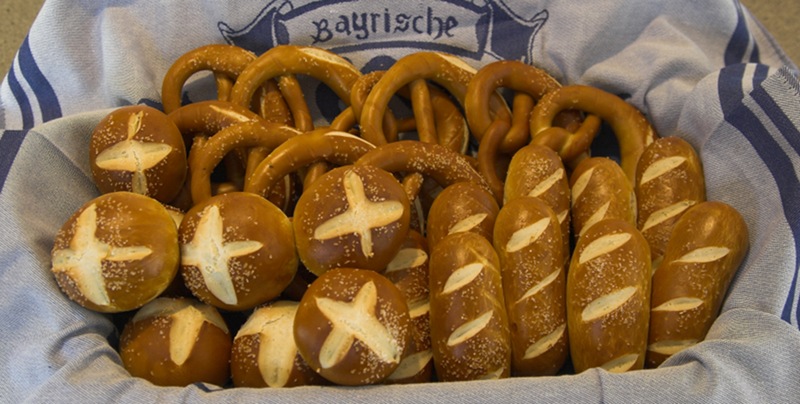From German brewing and more
|

If there is any German baked good that goes well with beer, it must be the Brezel (or Brezn' as the Bavarian says). The Brezel is part of a group of baked goods called Laugengebäck (lye bread) in Germany where you find many different shapes. I'm in particular a fan of the Laugenbrötchen (lye roll). Here I want to share how to make them at home.
The recipe that is used here comes from PDF document written for professional German bakers which I happened to come across on the internet [Ulmer Spatz]. I'm using the recipe for the Bavarian Breze scaled down from the 10,000 kg version.
This is what you need for the dough. Like many professional bread recipes it is completely weight based (except for the yeast):
| ingredient
|
metric
|
US. units
|
| bread flour
|
500 g
|
16 oz
|
| dry malt extract(*)
|
20 g
|
0.64 oz
|
| butter or margarine
|
10 g
|
0.32 oz
|
| salt
|
11 g
|
0.35 oz
|
| dry bread yeast
|
1 tsp
|
1 tsp
|
| water
|
245 g
|
7.84 oz
|
(*) if you don't have dry malt extract use 10g table sugar instead
 Figure 1 - weigh the ingredients. You don't have weigh them in separate containers as shown here. I tend to weigh them while adding them to the mixing bowl |
 Figure 2 - Using a powerful kitchen mixer kneed the dough for 10 min until smooth. You'll notice that Brezel dough is stiffer than normal bread or pizza dough. That makes the resulting bread denser but working with it much harder |
 Figure 3 - Once the dough has been kneaded let it rest for a few minutes before portioning. When making Brezels I don't want the dough to rise as it is more difficult to roll the necessary long strands if the dough has risen. To ensure evenly sizes Brezels and rolls I aim for about 70-80 g (2.4 - 2.5 oz) per dough ball. You may use more or less depending on the desired Brezel size |
 Figure 4 - Now form a smooth dough ball. This is done by stretching a thin membrane of dough over the ball and pinching it close at the bottom of the ball. Check out the last few minutes of Good Eat's Flat Is Beautiful. Alton Brown does a much better job describing it than I can do here. Keep in mind that it is easier to do with a soft pizza dough than a stiff Brezel dough. |
 Figure 5 - Place the ball on the counter with the top up and roll it around under your hand. This will smoothen it further. If the dough ball keeps slipping, moisten your hands with some water |
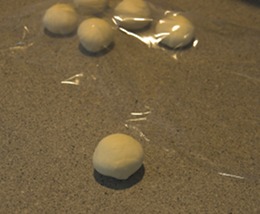 Figure 5 - In the end it will look like this. Keep the completed dough balls covered to prevent them from drying out |
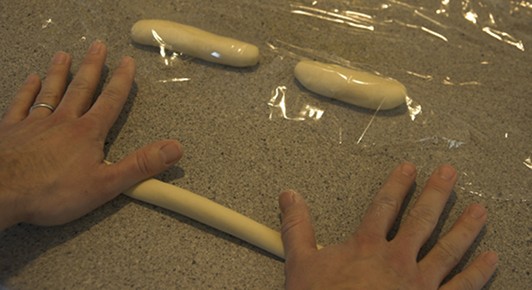 Figure 6 - To make Brezels you need to make long strands of dough. Take a dough ball and start rolling it into a stand. Moistening your hand makes rolling the fairly dry Brezel dough easier. You'll also notice that the dough doesn't like to be stretched very far. This is why you have to make the strands in steps. First roll them all to about 10 cm (4 in) in length and let them rest. Then roll them to about 25 cm (10 in) and let them rest again. Finally you should be able to roll and stretch them to about 40-60 cm (16-20 in). Resting the dough between rolling it allows the proteins to relax before they can be streched further |
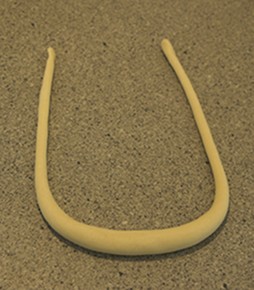 Figure 7 - Finally the strands will be long enough to be formed into a Brezel. Ideally the strands are slightly thicker in the middle and have a light taper towards the end. To tie the Brezel. Lay the strand in an U-shape.... |
 Figure 8 - ... pull the left end towards the right over and the right over to the left. |
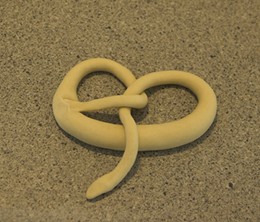 Figure 9 - Now take the end that is now on the right and pull it over to the left where you pinch it onto the Brezel. |
 Figure 9 - Do the same with the end that is now on the left. Done is your Brezel shape |
If you want to learn more about making bread check out these Good Eat's eposides on Youtube:
References
- [Ulmer Spatz] Backforum Bingen, Herstellung von Laugengebäcken, BIB-Ulmer Spatz
|














